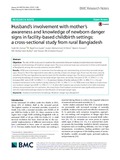| dc.contributor.author | Zaman, Sojib Bin | |
| dc.contributor.author | Gupta, Rajat Das | |
| dc.contributor.author | Al Kibria, Gulam Muhammed | |
| dc.contributor.author | Hossain, Naznin | |
| dc.contributor.author | Bulbul, Md. Mofijul Islam | |
| dc.contributor.author | Hoque, Dewan Md Emdadul | |
| dc.date.accessioned | 2022-03-07T04:56:09Z | |
| dc.date.available | 2022-03-07T04:56:09Z | |
| dc.date.copyright | 2018 | |
| dc.date.issued | 2018-05-09 | |
| dc.identifier.citation | Zaman, S. B., Gupta, R. D., Al Kibria, G. M., Hossain, N., Bulbul, M. M. I., & Hoque, D. M. E. (2018). Husband's involvement with mother's awareness and knowledge of newborn danger signs in facility-based childbirth settings: A cross-sectional study from rural Bangladesh. BMC Research Notes, 11(1) doi:10.1186/s13104-018-3386-6 | en_US |
| dc.identifier.uri | http://hdl.handle.net/10361/16409 | |
| dc.description | This article was published in the BMC Research Notes [© The Author(s) 2018. This article is distributed under the terms of the Creative Commons Attribution 4.0 International License (http://creativecommons.org/licenses/by/4.0/) ] and the definite version is available at: https://doi.org/10.1186/s13104-018-3386-6 The Journal's website is at: https://bmcresnotes.biomedcentral.com/articles/10.1186/s13104-018-3386-6#citeas | en_US |
| dc.description.abstract | Objective: The aim of this study was to examine the association between husband involvement and maternal
awareness and knowledge of newborn danger signs. This cross-sectional study was conducted in three rural hospitals
of Bangladesh among the recently delivered women (RDW).
Results: RDW were interviewed to determine their knowledge and understanding of seven key neonatal danger
signs. About 51.4% of the respondents were able to identify at least one danger sign. ‘Fever’ was the most correctly
identified (43.7%), and hypothermia was the least (26.1%) identified danger sign. The factors associated with RDW
possessing knowledge of at least one neonatal danger sign were: secondary education (COR: 1.3, 95% CI 1.1–1.6),
increased ANC visits (COR: 1.2, 95% CI 1.1–1.3), previous history of facility delivery (COR: 1.3, 95% CI 1.1–1.4), and
husband involvement in the mother’s facility delivery (COR: 1.3, 95% CI 1.1–1.5). RDW were more likely to recall at least
one newborn danger sign (AOR: 1.2, 95% CI 1.1–1.4) when the husband was actively involved in his wife’s antenatal,
delivery, and postnatal care. In conclusion, this study found that husband involvement was significantly associated
with the maternal knowledge related to identification of neonatal danger signs. | en_US |
| dc.language.iso | en_US | en_US |
| dc.publisher | BMC | en_US |
| dc.relation.uri | https://bmcresnotes.biomedcentral.com/articles/10.1186/s13104-018-3386-6 | |
| dc.rights.uri | Husband’s involvement with mother’s awareness and knowledge of newborn danger signs in facility-based childbirth settings: a cross-sectional study from rural Bangladesh | |
| dc.subject | Husband involvement | en_US |
| dc.subject | Knowledge | en_US |
| dc.subject | Newborn danger sign | en_US |
| dc.subject | Bangladesh | en_US |
| dc.title | Husband’s involvement with mother’s awareness and knowledge of newborn danger signs in facility-based childbirth settings: A cross-sectional study from rural Bangladesh | en_US |
| dc.type | Journal Article | en_US |
| dc.description.version | Published | |
| dc.contributor.department | Brac James P. Grant School of Public Health | |
| dc.identifier.doi | https://doi.org/10.1186/s13104-018-3386-6 | |
| dc.relation.journal | BMC Research Notes | |

